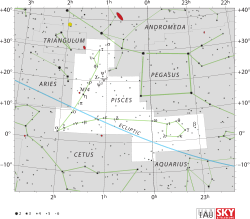Beta Piscium
 | |
| Observation data Epoch J2000 Equinox J2000 | |
|---|---|
| Constellation | Pisces |
| Right ascension | 23h 03m 52.61349s[1] |
| Declination | +03° 49′ 12.1662″[1] |
| Apparent magnitude (V) | +4.40[2] |
| Characteristics | |
| Spectral type | B6Ve[3] |
| U−B color index | −0.48[4] |
| B−V color index | −0.12[4] |
| Variable type | Suspected[5] |
| Astrometry | |
| Radial velocity (Rv) | 0.0 ± 0.6[6] km/s |
| Proper motion (μ) | RA: 11.76[1] mas/yr Dec.: −9.85[1] mas/yr |
| Parallax (π) | 7.99 ± 0.22[1] mas |
| Distance | 410 ± 10 ly (125 ± 3 pc) |
| Absolute magnitude (MV) | −1.01[7] |
| Details[3] | |
| Mass | 4.7 M☉ |
| Radius | 3.6 R☉ |
| Luminosity | 523.6[8] L☉ |
| Surface gravity (log g) | 4.0 cgs |
| Temperature | 15500 K |
| Rotational velocity (v sin i) | 90 ± 15 km/s |
| Other designations | |
| Database references | |
| SIMBAD | data |
Beta Piscium (β Piscium, abbreviated Beta Psc, β Psc), also named Fumalsamakah,[10] is a blue-white hued star in the zodiac constellation of Pisces. Its apparent magnitude is 4.40,[2] meaning it can be faintly seen with the naked eye. Based on parallax measurements taken during the Hipparcos mission, it is about 410 light-years (125 parsecs) distant from the Sun.[1]
Nomenclature
β Piscium (Latinised to Beta Piscium) is the star's Bayer designation.
It bore the traditional name Fum al Samakah from the Arabic فم السمكة fum al-samakah "mouth of the fish" (compare Fomalhaut).[11][12] In 2016, the IAU organized a Working Group on Star Names (WGSN)[13] to catalog and standardize proper names for stars. The WGSN approved the name Fumalsamakah for this star on 1 June 2018 and it is now so included in the List of IAU-approved Star Names.[10]
In Chinese, 霹靂 (Pī Lì), meaning Thunderbolt, refers to an asterism consisting of Beta Piscium and Gamma, Theta, Iota and Omega Piscium. Consequently, Beta Piscium itself is known as 霹靂一 (Pī Lì yī, English: the First Star of Thunderbolt).[14]
Properties
Beta Piscium is a Be star,[9] a special class of B-type stars with emission lines in their spectra. With a spectral type of B6Ve[3] its mass is estimated to be about 4.7 M☉, and its radius is about 3.6 R☉.[3] It is suspected to be a variable star.[5] Beta Piscium is radiating 524[8] times the Sun's luminosity from its photosphere at an effective temperature of 15,500 K.[3] The star has a high rate of spin, showing a projected rotational velocity of around 90 km/s.[8]
References
- 1 2 3 4 5 6 van Leeuwen, F.; et al. (2007). "Validation of the new Hipparcos reduction". Astronomy and Astrophysics. 474 (2): 653–664. arXiv:0708.1752. Bibcode:2007A&A...474..653V. doi:10.1051/0004-6361:20078357.
- 1 2 Ducati, J. R. (2002). "VizieR Online Data Catalog: Catalogue of Stellar Photometry in Johnson's 11-color system". CDS/ADC Collection of Electronic Catalogues. 2237. Bibcode:2002yCat.2237....0D.
- 1 2 3 4 5 Jones, C. E.; Tycner, C.; Sigut, T. A. A.; Benson, J. A.; Hutter, D. J. (2008). "A Parameter Study of Classical Be Star Disk Models Constrained by Optical Interferometry". The Astrophysical Journal. 687: 598–607. arXiv:0807.1515. Bibcode:2008ApJ...687..598J. doi:10.1086/591726.
- 1 2 Crawford, D. L.; Barnes, J. V.; Golson, J. C. (1971). "Four-color, Hbeta, and UBV photometry for bright B-type stars in the northern hemisphere". The Astronomical Journal. 76: 1058. Bibcode:1971AJ.....76.1058C. doi:10.1086/111220.
- 1 2 Samus, N. N.; Durlevich, O. V.; et al. (2009). "VizieR Online Data Catalog: General Catalogue of Variable Stars (Samus+ 2007-2013)". VizieR On-line Data Catalog: B/gcvs. Originally published in: 2009yCat....102025S. 1. Bibcode:2009yCat....1.2025S.
- ↑ Gontcharov, G. A. (2006). "Pulkovo Compilation of Radial Velocities for 35 495 Hipparcos stars in a common system". Astronomy Letters. 32 (11): 759–771. arXiv:1606.08053. Bibcode:2006AstL...32..759G. doi:10.1134/S1063773706110065.
- ↑ Anderson, E.; Francis, Ch. (2012), "XHIP: An extended hipparcos compilation", Astronomy Letters, 38 (5): 331, arXiv:1108.4971, Bibcode:2012AstL...38..331A, doi:10.1134/S1063773712050015.
- 1 2 3 Zorec, J.; Royer, F. (January 2012), "Rotational velocities of A-type stars. IV. Evolution of rotational velocities", Astronomy & Astrophysics, 537: A120, arXiv:1201.2052, Bibcode:2012A&A...537A.120Z, doi:10.1051/0004-6361/201117691.
- 1 2 "* bet Psc". SIMBAD. Centre de données astronomiques de Strasbourg. Retrieved 30 April 2017.
- 1 2 "Naming Stars". IAU.org. Retrieved 18 June 2018.
- ↑ HD-DM-GC-HR-HIP-Bayer-Flamsteed Cross Index, Kostjuk 2002, refer to table3.dat
- ↑ Allen, Richard Hinckley (1963) [1899]. Star Names: Their Lore and Meaning (Reprint ed.). New York, NY: Dover Publications Inc. p. 343. ISBN 0-486-21079-0.
- ↑ "IAU Working Group on Star Names (WGSN)". Retrieved 22 May 2016.
- ↑ (in Chinese) AEEA (Activities of Exhibition and Education in Astronomy) 天文教育資訊網 2006 年 7 月 8 日